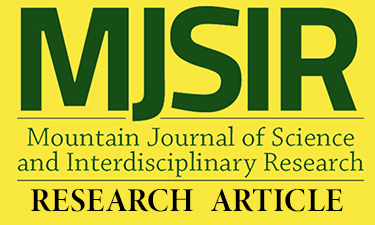Civil Engineering Students’ Problem-Solving Skills on Calculus-Based Problems
Main Article Content
Abstract
The main goal of learning mathematics is to solve problems. In engineering, problem solving and mathematics are always together. The study investigated the civil engineering graduating students’ mathematics problem-solving skills, specifically their level of solving skills, common errors, and strategies in solving mathematics problems. Thirty-six graduating civil engineering students taking the correlation course in a private school in Baguio City were the study's respondents. Results showed that the students have below satisfactory level of problem-solving skills. Although the level is low, students, in general, are able to understand the problem and represent it in a mathematical equation. Furthermore, most of the students’ errors in solving the problems are attributed to the use of incomplete formulas, errors on signs, errors in differentiating equations, and other typographical errors. Common students’ solving strategies involved remodeling, using a diagram, and using and deriving a formula. The study recommends programs to help students recall and practice mathematics concepts, especially calculus problems, such as retention programs, review classes, and other similar activities. If possible, students are encouraged to usea geometric representation or diagram when solving mathematical problems.
Article Details
References
Adams, R. (1983). Single Variable Calculus. AddisonWesley Publisher Limited, USA.
Arslan, Ã., & Altun, M. (2007). Learning To Solve Non-routine Mathematical Problems. Elementary Education Online, 6(1): 50–61. https://ilkogretimonline.org/?mno=121209
Ayres, F. (1987). Schaum's Outline of Theory and Problems of Differential and Integral Calculus, Second Edition. McGraw-Hill USA.
Barbado, S. (2013). Mathematical Proficiency in Geometry of High School Students. Unpublished Master’s Thesis. University of the Cordilleras (UC-BCF).
Baisley, A. (2019). The Influences of Calculus I on Engineering Student Persistence. All Graduate Theses and Dissertations. https://doi.org/10.2 6076/778c-8bf2
Calub, E. (1998). Performance in Problem Solving its Relationship to the Primary Abilities. Unpublished Master’s Thesis. University of the Cordilleras (UC-BCF).
Chegay, F. (2018). Inquiry-based Learning’ it’s Impact to Students’ Problem-Solving Performance in Series. Unpublished Master’s thesis. Benguet State University.
De Mello, J.C.C.B.S., Lins, M.P.E., De Mello, M.H.C.S., & Gomes, E.G. (2002). Evaluating the performance of calculus classes using operational research tools. European Journal of Engineering Education, 27(2): 209–218. https://doi.org/10.1080/03043790210129577
Elger, D., Beller, J., Beyerlein, S., & Williams, B. (2003). Session 2230 Performance Criteria for Quality in Problem Solving. Proceedings of the 2003 American Society of Engineering Education Annual Conference and Exposition. https://peer.asee.org/performance-criteria-for-quality-inproblem-solving-engineering-analysis.pdf
Felder, R., Woods, D., Stice, J., & Rugarcia, A. (2000). The Future of Engineering Education in Teaching Methods that Work. Chem. Engr. Education, 34(1): 26–39.
Fowler, D., Maxwell, D., &Froyd, J. (2003, June 22). Growth In Learning Strategies After Two Years In An Engineering Curriculum May Differ From Expectations. Proceedings of the 2003 American Society for Engineering Education Annual Conference & Exposition. https://peer.asee.org/growth-in-learning-strategies-after-two-yearsin-an-engineering-curriculum-may-differ-fromexpectations
Gainen, J., & Willemsen, W. (1995). Fostering Student Success in Quantitative Gateway Courses. New Directions for Teaching and Learning. San Francisco, CA: Jossey-Bass.
Gillesania, D.I. (2012). Engineering Mathematics Volume 2, third edition.
Gleason, J., Johnson, P., Bowen, L., Whitaker, K., Micu, C., Raju, D., & Slappey, C. (2010). Integrated engineering math-Based summer Bridge Program for student retention. Advances in Engineering Education, 1-17. https://files.eric.ed.gov/fulltext/EJ1076158.pdf
Grigg, S. (2012). A Process Analysis of Engineering Problem Solving and Assessment of Problem Solving Skills. All Dissertations. https://tigerprints.clemson.edu/all_dissertations/1012/
Halmos, P. (1980). The Heart of Mathematics. The American Mathematical Month, 87(7): 519-524.
Houghton, W. (2004). How can Learning and Teaching Theory. Assist Engineering Academics. https://www.heacademy.ac.uk/system/files/learningteaching-theory.pdf.
Krulik, S., & Rudnick, J. (1996). The New Sourcebook for Teaching Reasoning and Problem-Solving in Junior and Senior High School. Needham Height, Massachusetts: A. Simon & Schuster Company.
Maries, A., & Singh, C. (2017). Do students benefit from drawing productive diagrams themselves while solving introductory physics problems? The case of two electrostatic problems. European Journal of Physics, 39. 10.1088/1361-6404/aa9 038.
Martin, T. (2000). Calculus students’ ability to solve geometric related-rates problems. Mathematics Education ResearchJournal, 12(2): 74–91. https://doi.org/10.1007/BF03217077
Mohd-Yusof, K., Phang, F.A., & Helmi, S.A. (2014). How to develop engineering students’ problem-solving skills using cooperative problem-based learning (CPBL). QScience Proceedings, 2014(3), 30. https://doi.org/10.5339/qproc.2014.wcee2013.30
Nite, S.B., Allen, G.D., Morgan, J., Bicer, A., & Capraro, R.M. (2016). Engineering calculus bridge program success: Comparing variation results. 2016 ASEE Annual Conference & Exposition. American Society for Engineering Education. https://doi.org/10.18260/p.26624
Oryan, S. (2015). Student's Mathematical Knowledge Construction Patterns in Problem Solving Context. Benguet State University Research Journal, 74.
Pan, R., Strobel, J., & Cardella, M.E. (2014, June), Engineering Students’ Experiences of Workplace Problem Solving. 2014 ASEE Annual Conference & Exposition, Indianapolis, Indiana. 10.18260/1-2—20396
Patena, A.D.C., & Dinglasan, B. (2013). Students Performance on Departmental Examination: Basis for Math Intervention Program. SSRN Electronic Journal. https://doi.org/10.2139/ssrn.2 276044
Pusayen, E. (2016). Word Problem Solving Difficulties Encountered b the Grade 10 Students in Selected Private and Public Schools. Unpublished Master’s thesis. Benguet State University.
Rabacal, R. (2013). Skills on Non-Routine Problems of Mathematics Major Student of Saint Louis University, Baguio City. Unpublished Master’s thesis. Benguet State University.
Ryan, U. (1993). Advance Mathematics: Pre-Calculus Approach. Prentice-Hall.
Trends In International Mathematics And Science Studies. (2019). TIMMS 2019 International Results in Mathematics and Science.
https://timss2019.org/reports/wpcontent/uploads/ download/achievement/1_1-2_achievementresults-M4.pdf
Trance, N. J. (2013). Analysis of Oral Problem-Solving Skills in Mathematics of Engineering Students. US-China Education Review A, 3(2): 73-82.

